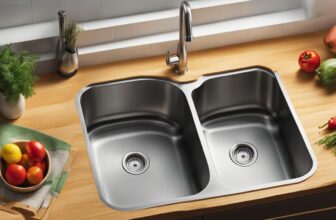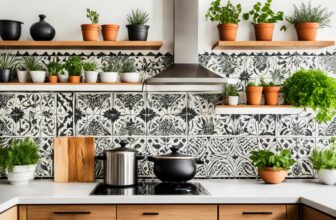Essentials for Your Chicken Coop Interior | Guide
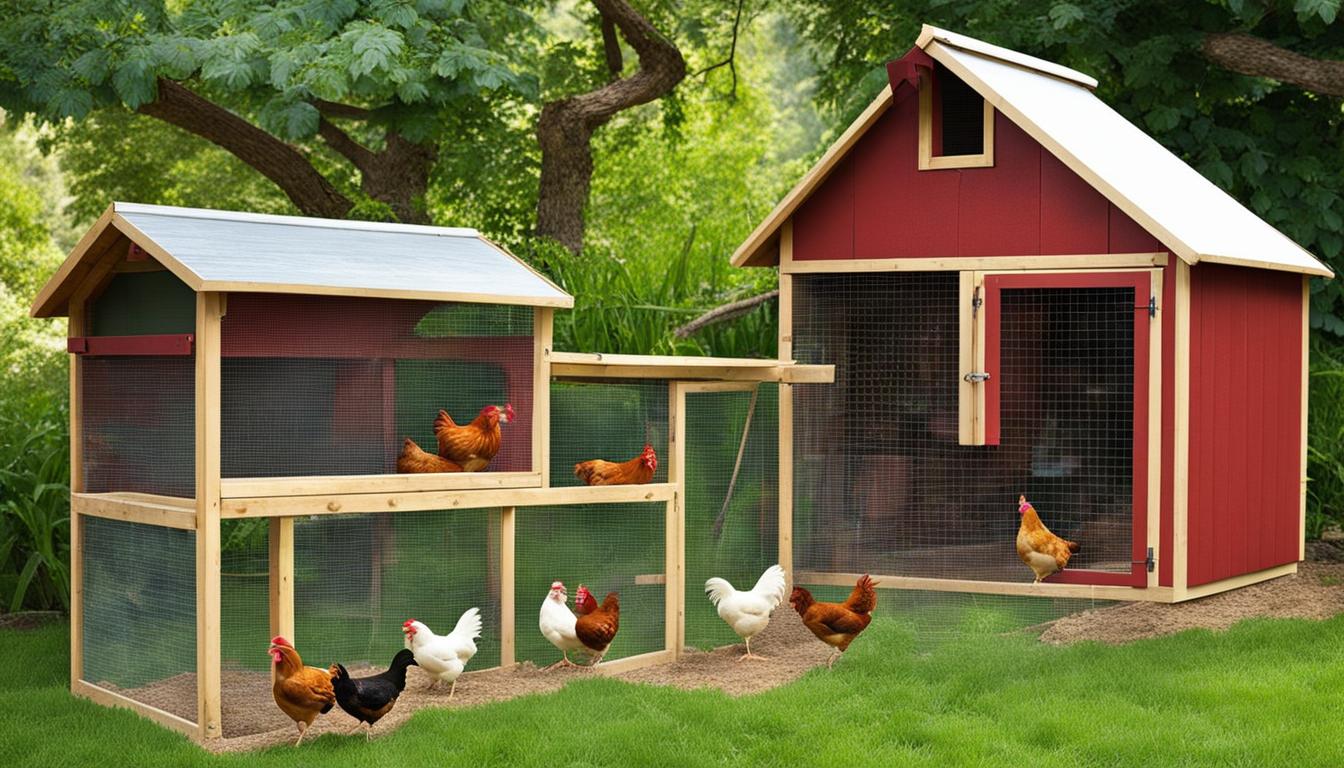
Welcome to our comprehensive guide on creating the perfect interior for your chicken coop. Whether you’re a first-time chicken owner or a seasoned poultry enthusiast, it’s essential to provide a safe and comfortable space for your feathered friends. In this article, we will explore the must-have features, equipment, and design considerations to ensure your chickens thrive in their coop.
When it comes to creating a chicken coop interior, there are several key elements to keep in mind. From adequate nesting boxes to proper ventilation, each component plays a vital role in the well-being of your flock. By paying attention to these essential factors, you can create a space that promotes their health, happiness, and productivity.
Key Takeaways:
- Ensure your chicken coop is equipped with essential features and accessories for their well-being.
- Proper coop design and layout play a crucial role in creating a comfortable environment.
- Incorporate nesting boxes and roosting perches to meet your chickens’ natural instincts.
- Provide ample ventilation and lighting for optimal air quality and natural day-night cycles.
- Choose the right flooring material and bedding for cleanliness and hygiene.
Coop Size and Layout Recommendations
When setting up your chicken coop, it’s essential to consider the right size and layout to ensure a comfortable and healthy environment for your flock. The coop’s size should provide sufficient space for the chickens to move around freely and engage in their natural behaviors.
There are various coop designs to choose from, each with its own benefits. Whether you opt for a traditional stationary coop, a mobile chicken tractor, or a spacious walk-in coop, it’s important to prioritize essential coop features such as nesting boxes, perches, and ventilation.
Types of Coops:
- Stationary Coops: These are sturdy structures that provide a fixed home for your chickens. They often have separate sections for nesting, roosting, and feeding. Stationary coops offer excellent protection from predators and generally provide ample space for your flock to roam.
- Chicken Tractors: These coops are designed to be easily moved around your yard, allowing your chickens to graze on fresh grass and insects. Chicken tractors are beneficial for improving soil health and preventing overgrazing of a specific area.
- Walk-In Coops: As the name suggests, walk-in coops offer spacious interiors and allow you to enter the coop comfortably. These coops are ideal if you have a large flock or if you prefer a coop model that provides ample headroom for cleaning and maintenance.
Regardless of the coop type you choose, it’s vital to consider the placement of nesting boxes, perches, and ventilation to ensure optimal coop interior design.
Considerations for Nesting Boxes, Perches, and Ventilation:
Nesting boxes are essential features of any chicken coop. They provide a safe and comfortable space for your hens to lay their eggs. The number of nesting boxes depends on the size of your flock, typically with one nesting box per four to five hens. Ensure the nesting boxes are easily accessible and filled with clean bedding material.
Roosting perches are another crucial component of a well-designed chicken coop. Chickens instinctively seek elevated perches to sleep at night. Provide enough perching space, approximately 6 to 10 inches per chicken, to accommodate their natural behavior. Make sure the perches are wide enough for the chickens to grip comfortably.
Ventilation is vital to maintain proper airflow and prevent moisture buildup inside the coop. Good ventilation helps regulate temperature, reduce odors, and prevent the growth of harmful bacteria. Consider installing windows, vents, or fans to ensure adequate air circulation within the coop.
Now that you have a better understanding of coop size and layout recommendations, you can choose the right setup that suits your flock’s needs. Remember to prioritize essential coop features such as nesting boxes, perches, and ventilation to create a comfortable and productive living space for your chickens.
Proper Flooring and Bedding
When it comes to creating a comfortable and clean environment for your chickens, choosing the right flooring material and bedding is crucial. Not only does it provide a cozy surface for your feathered friends, but it also plays a significant role in maintaining optimal coop hygiene. Here, we will explore various options and their benefits to help you make the best choice for your chicken coop.
Types of Flooring Material
When selecting a flooring material, keep in mind that it should be durable, easy to clean, and provide good insulation. Here are some popular options:
- Straw: Straw is a cost-effective and readily available option for coop flooring. It provides insulation during colder months and can be easily replaced when soiled.
- Wood Shavings: Wood shavings are another common choice, known for their absorbent properties. They help keep the coop dry and can be composted after use.
- Sand: Sand is an excellent option for coop flooring as it is easy to clean and offers natural drainage. It also discourages mites and lice from breeding.
Each flooring material has its advantages, so consider your specific needs and preferences when making a decision. You may even choose to combine different materials for different areas of the coop.
Choosing the Right Bedding
Alongside the flooring material, appropriate bedding is essential for maintaining a clean and comfortable coop. Bedding helps to absorb moisture, control odor, and provide a soft surface for your chickens. Here are some popular choices:
- Pine Shavings: Pine shavings are a popular choice for bedding due to their absorbency and natural fragrance. They are easy to clean and provide good insulation.
- Hemp Bedding: Hemp bedding is a natural and biodegradable option known for its high absorbency and odor control properties. It is also dust-free and helps maintain a healthy environment.
- Straw: Straw can also be used as bedding as it not only provides a soft surface but also helps with insulation and moisture absorption.
Remember to regularly clean out soiled bedding and replace it to maintain cleanliness and prevent the accumulation of harmful bacteria.
“Choosing the right flooring material and bedding is crucial for a clean and comfortable chicken coop.”
By selecting the appropriate flooring material and bedding, you provide your chickens with a comfortable and hygienic living space. This contributes to their overall well-being and helps maintain a healthy flock. Experiment with different options and find the combination that works best for you and your chickens.
Nesting Boxes and Roosting Perches
When it comes to creating a comfortable and functional chicken coop interior, nesting boxes and roosting perches are must-have supplies. These essential features not only provide your chickens with a cozy place to lay their eggs and rest, but they also contribute to their overall well-being and productivity.
The Ideal Placement and Size of Nesting Boxes
When designing your coop layout, it’s crucial to consider the proper placement of nesting boxes. Ideally, you should position them in a quiet and secluded area of the coop, away from high-traffic zones or perches to ensure privacy for your hens.
“Nesting boxes should be placed in a quiet and secluded area of the coop to provide privacy for your hens.”
The number of nesting boxes you’ll need depends on the size of your flock. As a general rule of thumb, one nesting box is required for every 4-5 hens. This ensures that each hen has sufficient space to lay her eggs comfortably.
Additionally, the size of the nesting boxes is an important consideration. The ideal dimensions for a nesting box are approximately 12-14 inches wide, 12-14 inches deep, and 12 inches in height. Providing enough room for the hens to enter, turn around, and comfortably lay their eggs is key to their nesting box experience.
The Importance of Adequate Roosting Perches
Roosting perches are essential for your chickens’ natural behavior and overall well-being. They serve as a safe place for your flock to perch, rest, and sleep during the night. Proper roosting perches contribute to their physical health by relieving pressure on their feet and legs, preventing foot pad injuries.
The ideal height for roosting perches is approximately 12-18 inches off the ground. This height provides enough space for your chickens to comfortably perch without risking injury by jumping or falling to the ground.
Additionally, the material you choose for the roosting perches is crucial. Opt for a sturdy and easy-to-clean material that is resistant to moisture and pests. Good options include natural branches or wooden dowels, which provide a comfortable and natural grip for your chickens.
To give your chickens a variety of perching options, consider providing different heights and widths for the perches. This allows them to choose their preferred roosting spot based on their individual comfort and hierarchy within the flock.
| Nesting Boxes | Roosting Perches |
|---|---|
|
|
Proper Ventilation and Lighting
Proper ventilation and lighting are essential coop features that promote the health and well-being of your chickens. In this section, we will explore the benefits of adequate airflow and natural lighting, as well as the use of artificial lighting to create an optimal environment for your flock.
The Importance of Ventilation
Good ventilation is crucial for maintaining fresh air circulation inside the chicken coop. It helps remove excess moisture, ammonia, and odors, reducing the risk of respiratory issues and maintaining optimal air quality for your chickens. Adequate airflow also helps regulate temperature, preventing the coop from becoming too hot or humid.
To ensure proper ventilation, consider the following:
- Provide vents or windows that can be opened and closed to allow for fresh air exchange.
- Place vents or windows strategically to create a cross-breeze and improve airflow.
- Avoid drafts by positioning the vents or windows at the higher end of the coop.
The Benefits of Natural Lighting
Natural lighting provides numerous benefits for chickens. Exposure to sunlight helps regulate their internal clock, promotes Vitamin D production, and enhances overall well-being. Additionally, natural light stimulates egg-laying and supports healthy growth in chicks.
Consider the following tips for maximizing natural lighting:
- Position the coop in an area that receives ample sunlight throughout the day.
- Ensure the windows or openings of the coop allow sufficient natural light to enter.
- Observe the flock’s behavior to ensure they have enough exposure to daylight.
The Role of Artificial Lighting
In addition to natural lighting, artificial lighting can be used to supplement or regulate light conditions in the coop. This is especially useful during winter months when daylight hours are shorter and can disrupt egg production.
Consider implementing the following practices for artificial lighting:
- Use a timer to simulate a natural light cycle and maintain consistent lighting conditions.
- Provide a minimum of 14-16 hours of light per day for optimal egg production.
- Avoid sudden changes in lighting to prevent stress or confusion among the flock.
Remember, a well-ventilated and properly lit coop contributes to the overall comfort and productivity of your chickens. By creating a suitable environment, you are ensuring the well-being of your flock and supporting their natural behaviors.
Now let’s move on to the next section, where we will discuss the essential feeding and watering systems for your chicken coop.
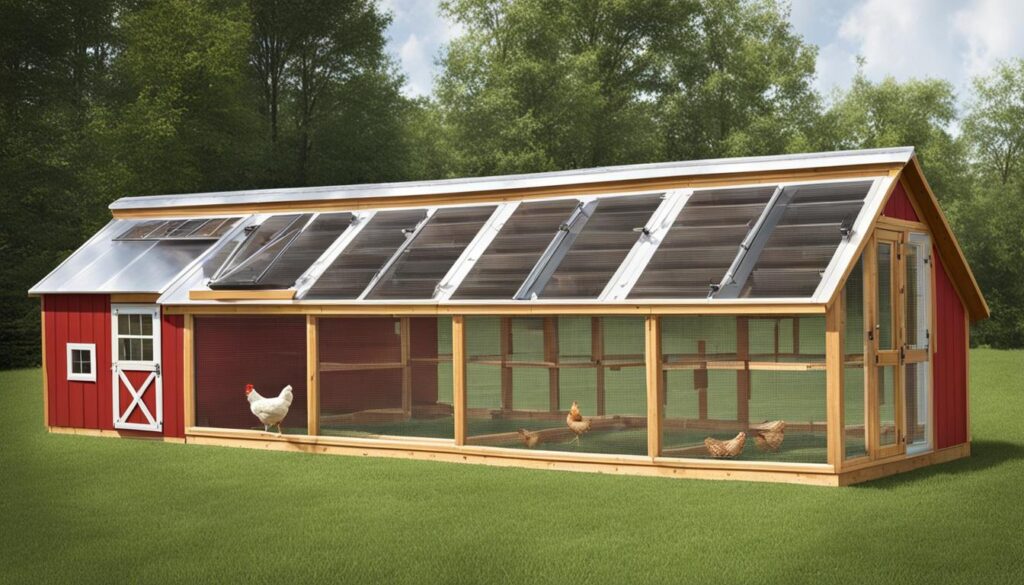
Feeding and Watering Systems
When it comes to providing for your chickens’ nutritional needs, having the right feeding and watering systems is essential. Not only do these systems ensure that your flock has access to fresh food and water at all times, but they also contribute to their overall health and well-being. In this section, we will explore several options for feeding and watering your chickens, highlighting must-have coop supplies and proper coop equipment.
Gravity Feeders
Gravity feeders are a popular choice among chicken owners due to their simplicity and efficiency. These feeders use gravity to dispense feed into the feeding tray or hopper, ensuring a steady supply of food for your chickens. They are easy to fill and maintain, making them a convenient option for busy poultry keepers. With a gravity feeder, your chickens can access food whenever they need it, promoting healthy feeding habits and minimizing waste.
Waterers
Proper hydration is crucial for your chickens’ well-being, and having the right waterers in your coop is essential. There are different types of waterers available, including traditional waterers, nipple waterers, and automatic waterers. Traditional waterers are simple and easy to use, while nipple waterers provide a clean and efficient way for chickens to access water. Automatic waterers, on the other hand, offer a continuous supply of water and reduce the need for frequent refilling. Choose a waterer based on the size of your flock and their specific needs.
Automatic Systems
If you’re looking for a more advanced option, automatic feeding and watering systems can be a game-changer. These systems are designed to deliver feed and water on a pre-set schedule, eliminating the need for manual intervention. Automatic feeders dispense the right amount of feed at regular intervals, ensuring that your chickens are well-fed even when you’re away. Similarly, automatic waterers can provide a constant supply of clean water, eliminating the risk of dehydration. These systems are particularly useful for larger flocks or when you’re unable to attend to your chickens throughout the day.
Remember, ensuring that your chickens have access to fresh food and water is crucial for their overall health and productivity. Consider the size of your flock and your specific needs when choosing feeding and watering systems for your chicken coop. By investing in must-have coop supplies and proper coop equipment, you can provide a nourishing environment for your chickens.
Health and Safety Considerations
When it comes to keeping your chickens safe and healthy, there are several essential coop features and proper coop equipment that you need to consider. By taking the necessary precautions, you can protect your flock from predator attacks, provide them with adequate insulation, and maintain a clean and pest-free environment.
Predator Protection
One of the key health and safety considerations for your chickens is preventing predator attacks. Ensure that your coop has a secure fencing system that keeps out roaming predators such as raccoons, foxes, and coyotes. Additionally, reinforce any weak spots or gaps in the coop structure and use sturdy latches on doors and windows to prevent unauthorized access.
“Protecting your coop against predators is crucial for the well-being of your flock. A strong and secure fencing system is your first line of defense.”
Insulation and Ventilation
Proper insulation is important to provide your chickens with a comfortable and stable environment throughout the year. Insulate the coop walls and roof to maintain a suitable temperature and protect your flock from extreme weather conditions. Consider using insulation materials such as foam boards or insulating paint to create an effective barrier against heat and cold.
In addition to insulation, proper ventilation is essential to ensure good air quality and prevent the buildup of harmful gases inside the coop. Install windows or vents that can be opened or closed as needed to allow fresh air to circulate without compromising the coop’s insulation.
Sanitation and Pest Control
Maintaining a clean and hygienic coop is vital for your chickens’ health and well-being. Regularly remove droppings, soiled bedding, and any spilled feed to minimize the risk of bacterial infections and attract pests. Consider using natural pest control methods such as diatomaceous earth or coop-friendly pest repellents to keep away common pests like mites, lice, and rodents.
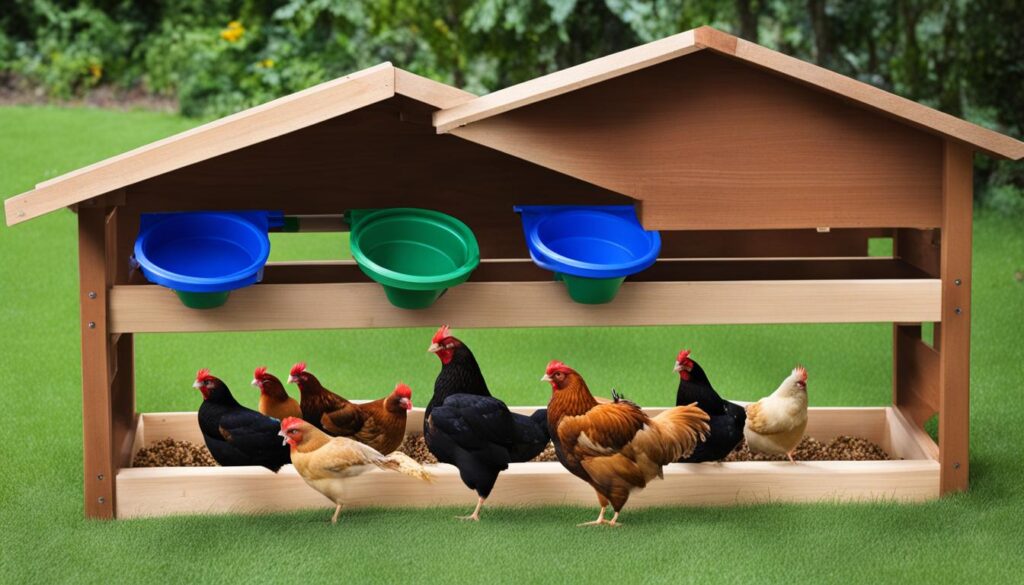
Summary Table: Health and Safety Considerations
| Health and Safety Consideration | Action |
|---|---|
| Predator Protection | Secure fencing system, reinforce weak spots, sturdy latches |
| Insulation | Insulate walls and roof, use suitable materials |
| Ventilation | Install windows or vents for proper airflow |
| Sanitation | Regular cleaning, removal of droppings and spilled feed |
| Pest Control | Use natural pest control methods, repellents |
By implementing these health and safety considerations, you can provide your chickens with a secure and comfortable environment, promoting their overall well-being and ensuring their longevity.
Coop Maintenance and Cleaning
Maintaining a clean and well-maintained chicken coop is crucial for the health and well-being of your flock. Regular inspections, cleaning schedules, and the use of appropriate equipment are essential coop features that ensure a hygienic environment. By implementing a few simple practices, you can promote the overall health of your chickens and enhance the longevity of your coop.
Regular Inspections
Performing regular inspections is key to identifying any issues or potential problems within your coop. Check for signs of wear and tear, damage to the structures, or holes that could allow predators to enter. Additionally, inspect the flooring, nesting boxes, and perches to ensure they are in good condition and functioning properly.
Cleaning Schedules
Establishing a cleaning schedule is essential in maintaining a clean and odor-free coop. Regularly remove any debris, droppings, or soiled bedding from the coop’s flooring and nesting boxes. This will help prevent the buildup of harmful bacteria and parasites that can negatively impact your chickens’ health. Replace the bedding as needed to provide a comfortable and hygienic environment for your flock.
Necessary Equipment
Having the right equipment for coop maintenance and cleaning can make the process easier and more efficient. Consider investing in tools such as a shovel, rake, broom, and wheelbarrow to assist in removing waste and keeping the coop tidy. Additionally, use disinfectants specifically designed for poultry coops to sanitize surfaces and minimize the risk of disease transmission.
“Regular inspections and proper cleaning schedules are vital for maintaining a healthy and hygienic coop environment.”
Proper Waste Management
Implementing proper waste management practices is essential for maintaining an odor-free coop and preventing the buildup of harmful bacteria. Install a composting system or designate an area for disposing of coop waste properly. This will not only help reduce environmental impact but also provide nutrient-rich compost for your garden.
Recommended Cleaning Schedule
| Task | Frequency |
|---|---|
| Remove droppings from flooring | Weekly |
| Replace soiled bedding | Bi-weekly |
| Clean nesting boxes | Monthly |
| Disinfect surfaces | Quarterly |
Following a regular cleaning schedule will help maintain a clean and healthy living space for your chickens. Remember, safety should always be a priority during coop maintenance, so wear appropriate protective gear such as gloves and masks if necessary.
By implementing proper coop maintenance and cleaning practices, you can create a comfortable and hygienic environment that promotes the well-being of your flock. A well-maintained coop is not only beneficial for your chickens’ health but also ensures enjoyable and rewarding experiences for poultry enthusiasts.
Conclusion
Creating a well-equipped and comfortable chicken coop interior is crucial for the health and happiness of your flock. Throughout this guide, we have discussed the essential features and accessories that should be included in your coop. From proper coop design and layout to choosing the right flooring and bedding materials, every aspect contributes to a safe and inviting environment for your chickens.
Remember to provide adequate nesting boxes and roosting perches, as well as proper ventilation and lighting. These factors directly impact the overall well-being of your chickens and their egg production. Additionally, invest in reliable feeding and watering systems to ensure convenient care.
Moreover, prioritizing health and safety considerations, such as protecting against predators and maintaining cleanliness, will help prevent diseases and ensure the longevity of your flock. Regular coop maintenance and cleaning are essential to sustain a hygienic environment.
By following these recommendations and incorporating the discussed essentials into your chicken coop interior, you are setting the foundation for healthy and content chickens. Provide them with a space that caters to their natural behaviors, and watch as they thrive in their coop’s comfortable and well-equipped environment.
FAQ
What should be inside a chicken coop?
Inside a chicken coop, you should have essential features such as nesting boxes, roosting perches, proper flooring and bedding, adequate ventilation and lighting systems, feeding and watering systems, and measures for health and safety considerations.
What are some chicken coop essentials?
Chicken coop essentials include nesting boxes for egg-laying, roosting perches for resting, appropriate flooring material and clean bedding, proper ventilation and lighting for air circulation and natural illumination, reliable feeding and watering systems, and measures for predator protection and coop cleanliness.
How should I design the interior of my chicken coop?
When designing the interior of your chicken coop, prioritize the placement and number of nesting boxes and roosting perches, choose suitable flooring material like straw or wood shavings, ensure proper ventilation and lighting, install functional feeding and watering systems, and keep health and safety considerations in mind.
What are the best coop accessories to have?
Some essential coop accessories include nesting box pads for comfortable egg collection and cleanliness, easy-to-clean waterers and feeders, predator-proof latches and locks, automatic door openers for added convenience, and reflective strips or predator deterrents for increased safety.
What supplies are must-haves for a chicken coop?
Must-have supplies for a chicken coop include nesting boxes, roosting perches, appropriate flooring material and bedding, ventilation and lighting systems, feeding and watering equipment, predator-proofing measures, cleaning tools, and necessary maintenance and repair items.
What are some recommendations for coop setup?
When setting up your coop, consider factors like the size and layout of the coop to provide sufficient space for your chickens, the placement and quantity of nesting boxes and perches, adequate ventilation and lighting, and easy access to feeding and watering stations.
Why is proper coop equipment important?
Proper coop equipment is important to ensure the health, safety, and comfort of your chickens. Suitable equipment helps maintain a clean and hygienic environment, supports proper egg-laying behavior, promotes good ventilation and lighting, and aids in feeding and watering efficiency.
How often should I clean and maintain my chicken coop?
It is recommended to clean and maintain your chicken coop on a regular basis. Perform inspections weekly, remove waste and soiled bedding as needed, replace bedding regularly, and deep clean the coop at least every few months to prevent the buildup of bacteria or pests.





